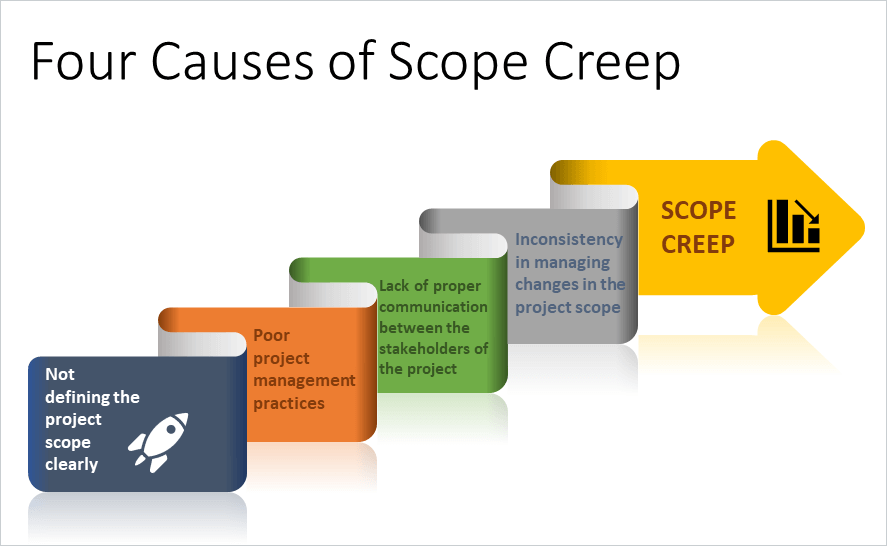The scope of the project reflects the work that needs to be done to complete the project. In project management, the three constraints – scope, schedule, and budget have a huge impact on the result of a project. When any one of the three constraints gets affected, the other two are affected as well. Scope Creep in project management is a result of changes that are made to the original scope of the project. These changes naturally affect the original project planning which results in the change to the whole project. There are several causes for scope creep and project managers try to avoid scope creep at all costs by following a few guidelines.

Jump ahead to
What is Scope Creep in Project Management?
Scope Creep can happen anytime in project management. When new project requirements are added to the original scope of the project, scope creep occurs. This affects all deliverables of the project, like the project schedule, budget, and resource allocation. It also affects the milestones and objectives of the project. Scope creep in project management is considered one of the common risks, and a good project manager always plans for it in advance.
While completing a particular project for your organization, one of the stakeholders requests some changes. Since the project is ongoing, as a project manager, you agree to follow the request. But the request is not approved by all the members of the project management team, or there is an insufficiency in resources. This affects the project and causes conflicts in reaching milestones. This is an example of scope creep.
Even when the requests are approved and the resources are provided for the completion of the project, the original scope, schedule, and budget need to be changed. Thus, scope creep affects every phase of the project development process, including its final delivery.
What causes Scope Creep?
Like other risks in project management, scope creep can be caused by various reasons. Sometimes they are planned and documented, but mostly they are unplanned, and project managers struggle to adjust the scope of the project because of scope creep. Here are the four main causes of scope creep in project management:
Not defining the project scope clearly.
Good project managers are aware of the importance of a clearly defined project scope. A well-defined project scope ensures that the project management team and the stakeholders know what to expect after the completion of the project. Scope creep is a project risk, and project managers must prepare for risk mitigation.
Poor project management practices
Organizations who adopt good project management practices can avoid scope creep. Following project management practices is a definitive path to achieving project success. Poor organizational project management practices are a prime cause of scope creep.
Lack of proper communication between the stakeholders of the project
Communication gap between the stakeholders of a project also leads to scope creep. When the project stakeholders do not agree on the client’s requirements that were not part of the project scope originally, the entire project management process gets affected due to scope creep.
Inconsistency in managing changes in the project scope
Risk mitigation is an essential skill for a project manager. If project managers cannot manage the changes in the project scope caused by scope creep, the project is bound to fail.
Does Scope Creep have any advantages?
Change is inevitable, but not necessarily bad. Scope creep can be advantageous for some projects. A project that originally did not have a good project scope can get better with the changes caused by scope creep. Similarly, clients’ requirements and market trends are ever-changing, through the course of the project, that requirement can get defined properly or become more defined. Also, scope creep can become useful for some projects as it will help project managers to improve their collaboration with project stakeholders and clients. This results in an improvement in the productivity of the project management team and helps generate more revenue for the organization as well.
How to Manage Scope Creep?
As mentioned above, scope creep is not always bad. However, this is true for only a small number of projects. Due to scope creep, most projects, especially long-term projects, affects a lot. Thus, actively mitigating this risk is crucial for achieving the desired objectives for the project. Here are some steps project managers adopt to manage scope creep:
- Define the project scope clearly.
- Adopt established project management practices.
- Give importance to tasks and communicate with the project management team regularly.
- Establish a good communication channel between the project stakeholders and the clients of the project.
- Use your knowledge of project management methodology and say no to requirements by stakeholders or clients that are beyond the project scope.
Conclusion
A good project manager knows how to avoid scope creep at all costs through effective project planning. In the case of scope creep, they use their project management knowledge and skills to manage it effectively. So, the project gets completed on schedule and within the estimated budget. With a proper understanding of the various kinds of risks in project management, like scope creep, project managers can help achieve the objectives of the organization by ensuring project delivery success. Individuals can acheive this by earning the Project Management Professional (PMP) Certification through training provided by a verified training provider. Also, project managers can improve their project management knowledge and become PMP Certified.



